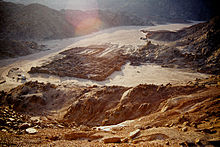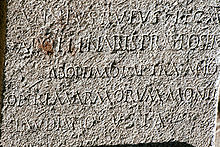- Mons Claudianus
-
Mons Claudianus was a Roman quarry in the eastern desert of Egypt. It consisted of a slave settlement, a garrison and a quarrying site. Black Quartz diorite was mined for the Roman Empire where it was used as a building material. Mons Claudianus is located in the mountains of the Egyptian Eastern desert about midway between the Red Sea and Qena. Today tourists can see fragments of granite, with several artifacts such as a broken column. A number of texts written on broken pottery (ostraca) have been discovered at the site. They show that unlike the situation at many other Roman quarries, most of the Mons Claudianus workers were free, not slaves.
The grey granite columns of the Pantheon in Rome were quarried at Mons Claudianus. Each was 39 feet (12 m) tall, five feet (1.5 m) in diameter, and 60 tons in weight.[1] These were dragged more than 100 km from the quarry to the river on wooden sledges. They were floated by barge down the Nile River when the water level was high during the spring floods, and then transferred to vessels to cross the Mediterranean Sea to the Roman port of Ostia. There, they were transferred back onto barges and pulled up the Tiber River to Rome.[2]
References
- ^ Parker, Freda, The Pantheon - Rome - 126 AD, Monolithic, http://www.monolithic.com/stories/the-pantheon-rome-126-ad, retrieved 2009-07-08
- ^ Wilson-Jones 2003, The Enigma of the Pantheon: The Exterior, pp. 206-212
- Peacock, D.P.S. and Maxfield, V.A. (1997) Mons Claudianus: Survey and Excavation. ISBN 2-7247-0192-5
- Mons Claudianus. Ostraca graeca et latina. [SEVPO]
Vol. I, ed. J. Bingen, A. Bülow-Jacobsen, W.E.H. Cockle, H. Cuvigny, L. Rubinstein and W. Van Rengen. Cairo 1992. (Institut Français d’Archéologie Orientale, Documents de Fouilles 29). Nos. 1—190.
- Vol. II, ed. J. Bingen, A. Bülow-Jacobsen, W.E.H. Cockle, H. Cuvigny, F. Kayser and W. Van Rengen. Cairo 1997. (Institut Français d’Archéologie Orientale, Documents de Fouilles 32). Nos. 191—416.
- Vol. III, Les reçus pour avances à la ‘familia,’ ed. H. Cuvigny. Cairo 2000. (Institut Français d’Archéologie Orientale, Documents de Fouilles 38). Nos. 417-631.
alternatively for a tourists holiday pictures see:
- Mallett, Simon; Whittle, Lesley (2002-02). "Mons Claudianus 1998". http://www.yaroe.freeserve.co.uk/monsclaud1998/monsclaudianus.htm. Retrieved 2008-06-01.
Coordinates: 26°48′32″N 33°29′13″E / 26.809°N 33.487°E
This Ancient Rome-related article is a stub. You can help Wikipedia by expanding it.


